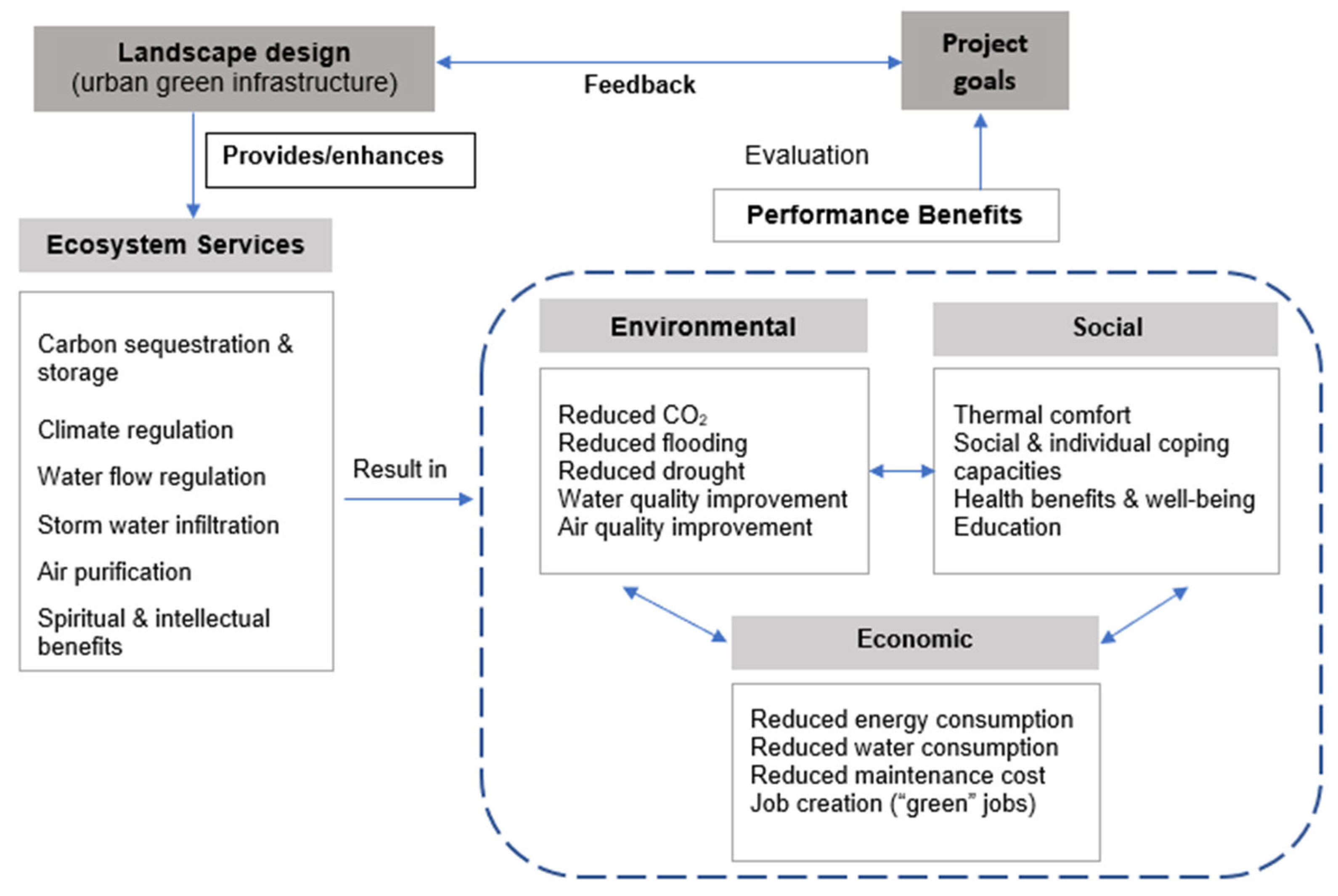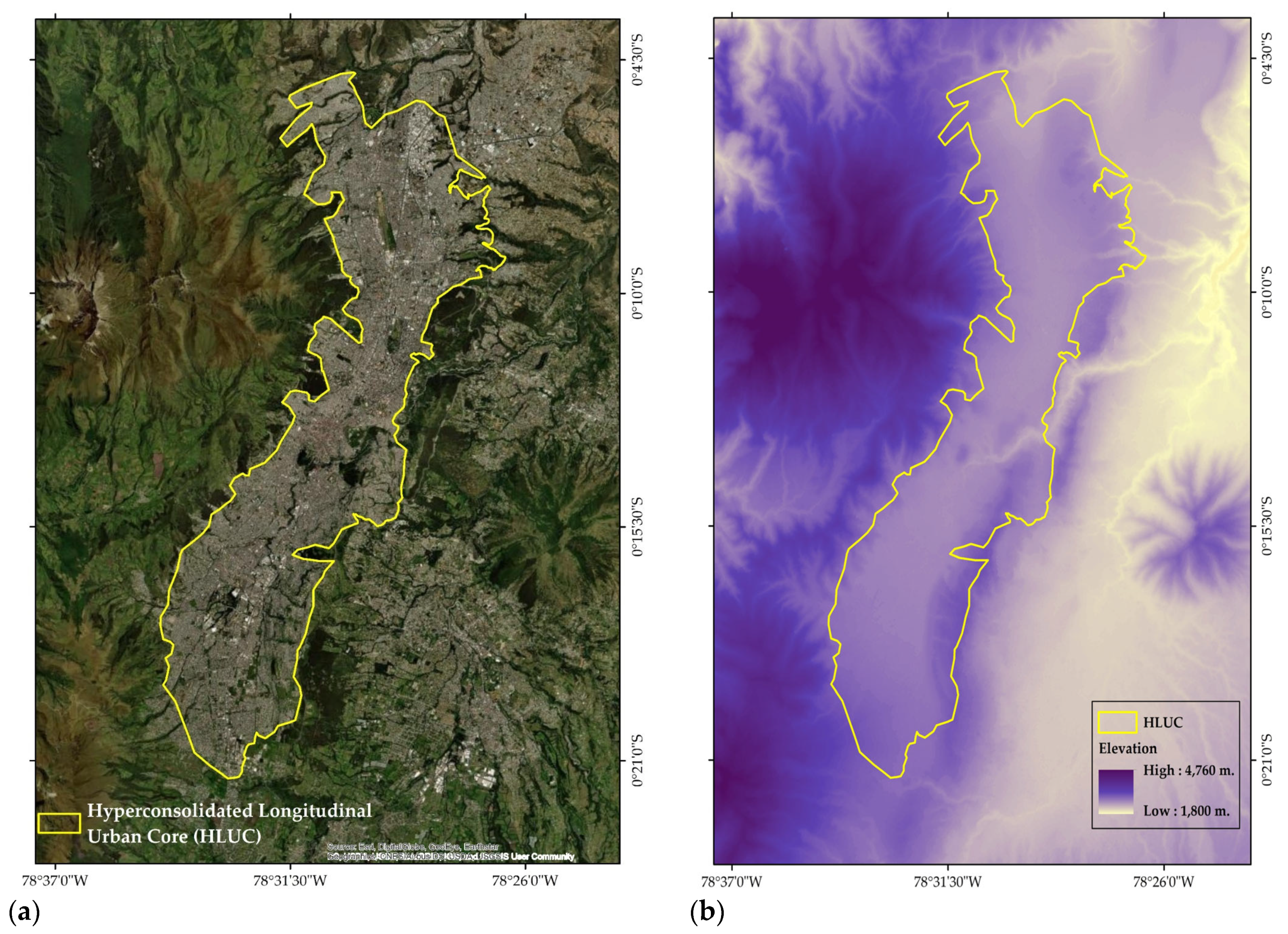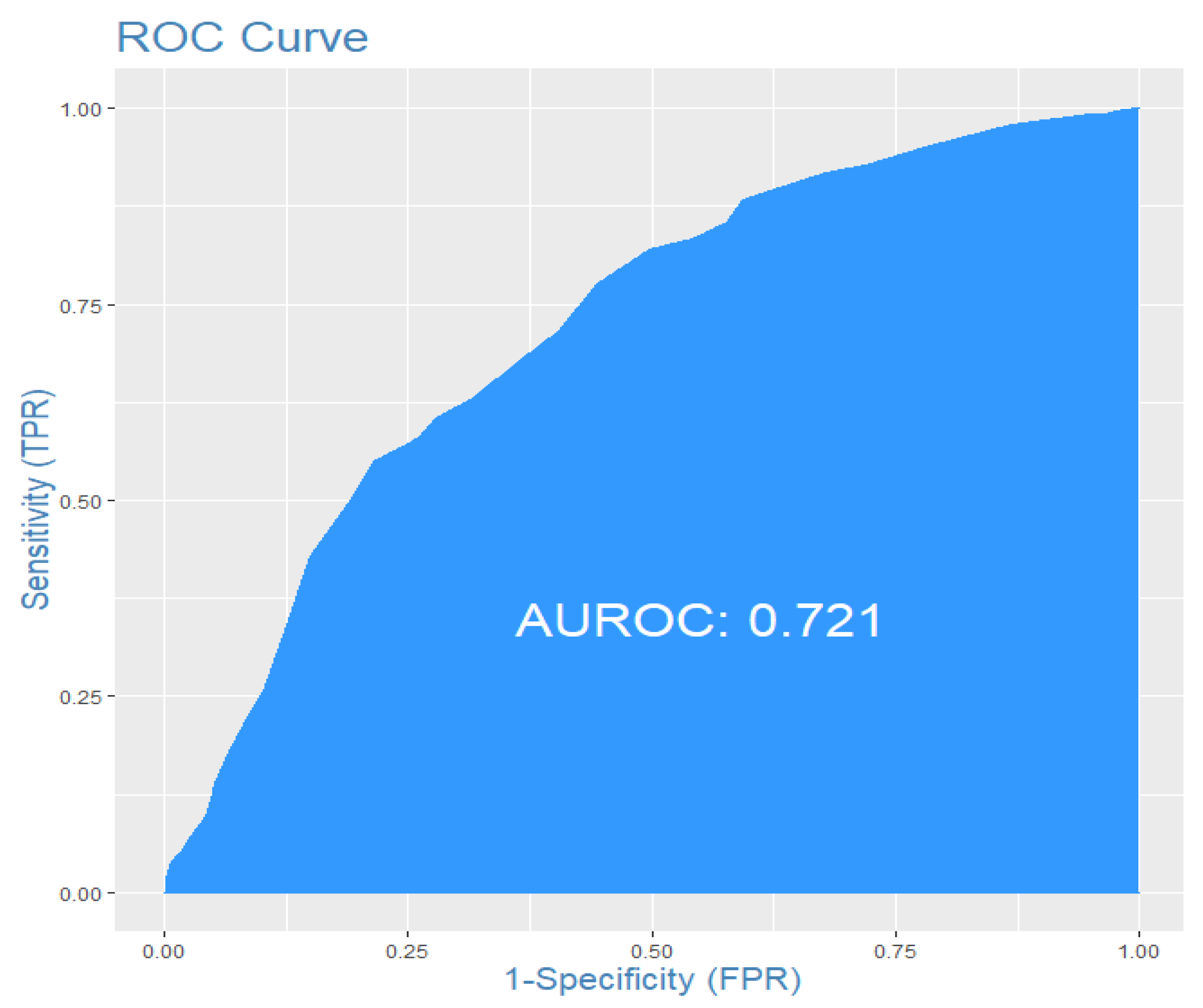1. Introduction
The most sustainable cities in the world are characterized by having a high proportion of natural and anthropic green spaces, as well as diverse habitats with urban vegetation and biodiversity [
1].
The traditional approach to urban planning, originally aimed to improve sanitary conditions in cities, has changed to a paradigm of sustainability that incorporates urban green spaces into the city to create a more attractive environment for the inhabitants themselves.
According to [
2], approximately 80% of residents of urban areas worldwide are exposed to air pollution levels above those established in the World Health Organization’s air quality guidelines (WHO). In addition, rapid and unsustainable urbanization has significant environmental and social consequences, when urban infrastructure is abruptly introduced without preserving sufficient green spaces in the city and the recreation of its inhabitants. The impact of vegetation in the city is of great concern to decision-makers and planners of public policies, mainly due to urban expansion.
Planning and integrating vegetation into the urban system brings systematic benefits on three interrelated axes: (1) the social axis, which improves citizens’ quality of life through comfortable environments for coexistence and recreation; (2) the ecological axis, vegetation mitigates urban impacts that negatively affect the environment, such as e.g., temperature, noise, cityscape, but mainly as a complement to prevent flooding, landslides, and alluvial deposits; and (3) the economic axis, the acquired social benefits, by increasing the quality of life, directly increases the value of the land and consequently acquires an added value [
3].
Parks, green spaces, streams with natural vegetation, and watercourses located within the city are generally public spaces that need to be studied as part of a strategic interest to combat threats such as climate change, which is defined in the Sustainable Development Goals (SDGs), including sustainable cities, public health, and conservation. Several studies also demonstrate the impact of incorporating urban green spaces on community health. Among the most important are mental health, depression, and reductions in mortality from cardiovascular disease, obesity, and diabetes [
4].
Refs. [
5,
6] agree that cities need trees and water to be habitable. They also articulate the public perception and impact of failed urban planning leading to the loss of urban vegetation.
One oft-repeated phrase that has become an “unconfirmed truth” is the one that establishes a minimum of 9 m
2 of green space per inhabitant, purportedly from the World Health Organization (WHO). However, there is no source that confirms these values. Ref. [
7] compiles the analysis of 386 European cities with population densities comparable to Latin American cities and gives values between 15 m
2 and 50 m
2 of green space per inhabitant. Similarly, [
8] identifies the range between 3 m
2 and 12 m
2 per inhabitant.
Latin American cities are generally lower than the average issued by WHO and much lower than the European average. In this way, a relationship can be established between the level of economic development of Latin American countries and public green spaces [
9]. This, interpolated to the city of Quito and complemented by the observation of the different urban sectors of the city, allows us to assume that, in general, the maintenance of the richness of urban vegetation in general depends largely on the socioeconomic level and development of the different sector.
In addition, cities will increasingly need to increase their resilience to cope with the impacts of climate change and natural disasters within them. Urban heat islands and unexpected flooding are expected to increase as cities grow [
10]. Urban vegetation and green spaces established throughout the city are directly related to sustainable urban drainage practices (SUD), which provide environmental and social benefits; they also help manage the complications caused by rainwater and stormwater (runoff) [
11].
Classical approaches to the study and planning of Green Infrastructure (GI) focus only on social benefits related to recreation and landscape; strongly associated with the concept of the “garden”, which has led to GI urban planning being underestimated in recent decades and appearing as a low priority in public policy [
12,
13]. GI appears strongly in the design and planning of urban and peri-urban environments only in the last two decades [
14].
For [
15], urban GI is a system of green spaces that maintain the value of natural ecosystems [
16,
17,
18], which states that urban green spaces have biophysical properties that help cities adapt to climate change.
Figure 1 shows the cycle of benefits and the evolution of ecosystem services provided by GI.
According to [
19], GI can be defined as “an interconnected network of green spaces that preserves the functions and values of natural ecosystems and provides corresponding benefits to human populations”. In this way, what [
20,
21] say about understanding cities as sustainable ecological-sociological-economic systems is confirmed. Urban green space refers to a variety of green open spaces, for example, public parks, residential gardens, green roofs, and street trees [
22].
Apart from an absolute definition of urban GI, it is built by its origin and concepts related to scientific and technical approaches to urban growth, environmental protection, quality of life, socio-economic realities, links between urban environments, and natural urban drainage, among others, which form the link between theoretical bodies and practice in the context of urban planning. However, the gap in technical and methodological frameworks linking the city to ecosystem services and GI is still large, especially in regions such as Latin America and the Caribbean (LAC) [
23].
According to [
24,
25], the elements of GI at different levels that maximize social benefits and ecosystem health can be classified as follows: (1) Neighborhood level: squares, green roofs, and walls, tree-lined streets, private gardens, institutional open spaces, ponds and streams, right-of-way, pedestrian and bicycle paths, cemeteries, sports fields, small forests, streams, orchards, wastelands; (2) City level: rivers and floodplains, intermunicipal parks, urban canals, lagoons, urban forests, natural parks, contiguous water areas, urban plazas, hills, large recreation areas, estuaries, wastelands, community forests, agricultural lands, landfills, and; (3) regional level: Protected wilderness areas, national parks, coasts and beaches, strategic and long-distance trails, forests, shelterbelts in power lines, road and rail networks, designated greenbelts, agricultural lands, rivers and floodplains, canals, mountain ranges, aqueducts, fault lines, and lakes.
The importance of maintaining urban GI becomes more relevant in situations of high globalized uncertainty, especially those related to climate change and the associated impacts of global warming [
26]. For example, one of the most prominent and consistent benefits of urban vegetation is the reduction and control of urban surface temperature by providing shade while absorbing solar radiation (transpiration and photosynthesis) [
27].
The systematic implementation of GI leads to the transformation of cities into so-called eco-cities, which are characterized by the maintenance of an ecological approach to urban design. That is, cities are understood as ecosystems where technologies to protect the environment, economic activities, and waste are efficiently managed to protect the environment. Reducing urban heat islands and promoting the use of GI are also components that stand out in this concept [
28]. Similarly, eco-neighborhoods and eco-communities are derivatives of eco-city trends due to the need to create green spaces at the residential level and ensure ecosystem services within cities.
GI-based planning and design approaches have become best practice for achieving the concept of urban resilience because of their multifunctionality. They also support urban policies to address environmental issues, including stormwater regulation, air quality, urban heat islands, and landscape connectivity [
29].
The presence of natural or anthropogenic urban vegetation in the city plays a key role in different approaches and dimensions in the territories, e.g., SUDs are part of GI and their functionality can be compared to traditional urban stormwater management systems (including unified networks and stormwater and wastewater disposal) [
30].
The approach of SUD can be traced back to the “Clean Water Act” and the National Pollution Discharge Elimination System of the United States of America, which introduce these techniques as Best Management Practices (BMPs) and complement conventional stormwater treatment. Since then, SUDs have been viewed as more flexible and efficient drainage systems to manage the risks associated with runoff and urban flooding (stormwater quality and quantity) and to improve the landscape of the city [
31,
32].
According to the ICLEI European Secretariat (2011), SUDs are considered management and planning techniques that attempt to replicate hydrologic processes such as infiltration, filtration, storage, lamination, evapotranspiration, and others, but primarily techniques for controlling runoff and integrative resources of the urban landscape. Ref. [
33] argues that SUDs as a whole mimic the behavior of a hydrographic basin in its natural state, helping to improve the condition of water masses, protect against floods and droughts, adapt and mitigate climate change (CO
2 sinks), reduce solids entrainment, provide ecosystem services, and enhance green spaces.
Over the past three decades, the growing need in LAC cities to improve stormwater and runoff management to mitigate the impacts of urban flooding has motivated the application of BMPs through regulations and ordinances that encourage their use and application. For example, European, North American, and Australian countries have their own SUD regulations, manuals, and drafts [
34]. According to [
35], the reduction in water treatment costs when using SUD techniques is generally between 18% and 50%.
The drastic change in land use in cities and their sphere of influence, due to economic development and population growth, primarily results in natural ecosystems being altered and replaced by buildings and roads (grey infrastructure), which inevitably changes the quality of life of residents, for better or worse [
36]. As a result, the provision of ecosystem services provided by urban vegetation is becoming increasingly complex, especially in regions such as LAC [
37].
Currently (2022), the ecosystem benefits of urban vegetation are recognized worldwide. However, many cities around the world do not provide adequate conditions for access and use of this resource [
38,
39]. According to [
39,
40], socioeconomic factors have proven to be one of the limiting factors in the provision and public amenities of urban green spaces and elements in quality and quantity; resulting in the most disadvantaged socioeconomic groups lacking urban IG.
In LAC cities, where 80% of the population lives in cities with marked social inequality [
41,
42,
43]. The authors [
42,
43,
44] found that citizens with better economic income in Santiago de Chile have better access to green spaces and tree species. In the case of Bogotá, a lower occurrence of GI was found in the poorest areas of the city [
45].
The objective of this study is to establish the relationship between the density of urban vegetation and the socioeconomic conditions of urban areas in the city of Quito, Ecuador, using Geographic Information Systems (GIS), spatial analysis, and remote sensing. In this way, the conservation, maintenance, and inclusion of vegetation areas in 2021 are evaluated under the influence of socioeconomic factors. The specific question underlying this study is: to what extent do the socioeconomic situation and the quality of life of the inhabitants of Quito influence the conservation and maintenance of anthropogenic and natural urban vegetation?
4. Discussion
Refs. [
45,
60] analyze tree inequality in Bogotá in relation to socioeconomic strata. Ref. [
61] similarly refers to socioeconomic characteristics as predictors of GI. This study analyzes the distribution of natural and anthropogenic vegetation, including trees in the HLUC of Quito, and its relationship with socioeconomic factors.
The accuracy of the analysis of this work is based on the AIVAS, which is a more accurate territorial approximation than the urban parishes (much larger areas than the AIVAS), and it is also analyzed at the parish level. Ref. [
37] analyzes the distribution of public GI based on the zonal planning units of the city of Bogotá, which are units with similar land use and urban development, analogous to the AIVAS. These approximations make it possible to better relate socioeconomic conditions to vegetation density and also assess the resilience, sustainability, habitability, and ecosystem services of the AIVAS.
The importance of calculating NDVI within cities has become increasingly important to create indicators for planning and design. Ref. [
62] evaluates the greening and activities that take place in the neighborhoods of Warrnambool, Australia, using the NDVI, Ref. [
37] estimates forest cover in urban areas at the level of the planning area of Bogotá (larger than a neighborhood). Therefore, the calculation of the NDVI to quantify the green areas at the level of AIVAS is practical in this work.
The modeling of urban vegetation is countless and serves different purposes, for example, modeling thermal and energy regulation (urban microclimate) as shown in the work of [
63], evaluating the relationship between GI and SUDs [
64] or studies on hydrological modeling with the work of [
65]. In this case, the relationship between socioeconomic factors and urban vegetation density is evaluated by a spatial and non-spatial statistical study combined with remote sensing (NDVI). However, it should be taken into account that the calculation or approximation of socioeconomic factors is complex since it is not an observable variable in itself [
66]. and therefore, there is no specific formula to determine the phenomenon, but methods that take into account variables that allow differentiation of layers and grouping of areas with similar characteristics. This can be demonstrated in the study of [
37,
42,
45].
Refs. [
6,
67] comment on the negative socio-environmental impacts and consequences of replacing green spaces with grey infrastructure. Ref. [
68] also assesses vegetation changes associated with urbanization processes. In addition to assessing vegetation density in sectors where grey infrastructure is prevalent, this study proposes basic analyzes and studies to characterize issues related to city surface temperature (heat islands), urban drainage, green space restoration, and the creation of more GI in the HLUC.
5. Conclusions
Satellite resources that have the elements (sensors-bands) to calculate NDVI are an indispensable tool for this type of study. Sentinel L2 imagery provides spatial resolution up to 10 m., which means that up-to-date information is available to analyze vegetation density in a space-time approach.
Because of the multiple social, environmental, and economic interactions among residents in the HLUC of Quito, parish-level socioeconomic analyzes prove to be highly generalized, making it imprecise to establish a relationship between vegetation density and socioeconomic conditions at this territorial scale. Therefore, urban vegetation analyses at the AIVAS level are more appropriate in cases involving socioeconomic variables.
The AIVAS are a very useful tool for the city of Quito. The information they provide allows the carrying out of accurate studies on territorial assessment and socioeconomic conditions since they are constantly maintained and updated. This source of information is the most important factor for the evaluation of vegetation density in the study area. However, the results of the two levels of analysis (AIVAS level and parishes level) suggest that socioeconomic factors contribute to understanding the density of urban vegetation, but they are not decisive by themselves.
It can be concluded that unlike other cities in the region, such as Santiago de Chile and Bogota, where several authors confirm that the sectors with low socioeconomic conditions have a lack of public, ornamental, and private urban vegetation, while the sectors with medium-high and high socioeconomic conditions enjoy and maintain a higher density of vegetation, establishing a direct and general relationship in the city. In the HLUC of Quito, the relationship is neither direct nor proportional. In fact, most AIVAS with vegetation index above 30% are concentrated in the low and medium socioeconomic sectors, while in the medium, medium-high, and high socioeconomic sectors, AIVAS have vegetation indices below 30%. Therefore, it is indicated that complementary explanatory variables should be included and that analyzes should be developed using nonlinear mathematical-statistical approaches.
Application of the logistic model in areas with a vegetation index of less than 30% revealed that factors related to green spaces and green infrastructure (I5) in combination with socioeconomic factors (I2, I3, and I4) largely explain the vegetation index in these areas. Moreover, it is confirmed that the medium, medium-high, and high socioeconomic levels tend to affect areas with a low vegetation index (<30%).
Historically and geographically, the HLUC of Quito concentrates the richest areas (high socioeconomic conditions) in the north center, which at the same time results in a concentration of AIVAS with low vegetation indices, i.e., confirming the results of this work. Therefore, more attention needs to be paid to these areas to preserve and promote urban GI and green spaces to counteract the effects of high urban surface temperatures and polluted air and to create natural urban drainage areas.
Finally, the city of Quito is vulnerable to natural risks, it has fewer and fewer green areas in the HLUC, and there is no public policy with an ecosystem approach. Therefore, the results of the analyses conducted in this paper contribute as research and fundamental studies to the planning, design, and implementation of techniques and methods for sustainable urban drainage systems. In addition, this type of study supports the characterization of urban vegetation density and SUDs to strengthen the resilience, sustainability, and habitability of the city.
















